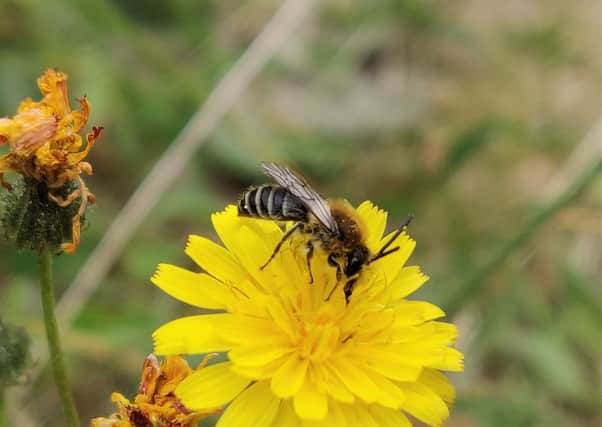Creating a buzz as secrets of bee revealed


The research to learn more about the bee known as Colletes floralis was commissioned by the National Trust NI, funded by the Department of Agriculture, Environment and Rural Affairs (DAERA) and carried out by Buglife.
Listed as a priority species, the Colletes floralis is found in dry dune slacks in the North Coast.
Advertisement
Hide AdAdvertisement
Hide AdFeaturing a medium sized body, black abdomen with narrow white bands, and a fox-coloured face and thorax, this is a solitary bee, meaning a single female constructs and provisions a nest.
Threatened by loss of breeding and feeding habitat, the bee has been recorded nesting at four sites on the North Coast, two of which, Portstewart Strand and White Park Bay, are owned by the National Trust.
Keen to understand more about the bees’ natural environment, the National Trust worked in partnership with Anna Hart from Buglife, to assess the bee’s nesting sites and build a fuller picture of their habitat, food source and population.
Working in the dunes during the bee’s flight period, from mid-June to mid-August, Anna spotted large numbers of the bees on her visits to White Park Bay and Portstewart Strand. Through close observation she was able to identify umbellifers as the bee’s key food source. Characterised by umbrella-like shaped flowers, plants such as wild carrots were revealed as vital food sources for the protection of the species. Yellow composites such as cats-ear, wild thyme and bramble were also a food source.
Advertisement
Hide AdAdvertisement
Hide AdThese flowers have recently been thriving in the dunes thanks to the removal of Sea Buckthorn, an invasive non-native species that outcompetes native plant species for food and light. The removal of Sea Buckthorn at these sites has provided bare sand and allowed more opportunities for the female bees to find nest site. Bare sand soon becomes colonised by native plants, providing a vital food source for the bees to expand.
The female bees were also observed zig zagging over the ground where scrub removal had taken place, a behaviour linked to nesting. These areas of scrub removal will need to be monitored to see whether the bee population increases here over time.
Danielle Shortall, nature recovery project officer, National Trust, said: “The research is very exciting. It means we can manage the dunes for the bees. Obviously with climate change, the pollinators are really in decline, so as a conservation organisation we want to be doing our best to help these pollinators.”
Comment Guidelines
National World encourages reader discussion on our stories. User feedback, insights and back-and-forth exchanges add a rich layer of context to reporting. Please review our Community Guidelines before commenting.